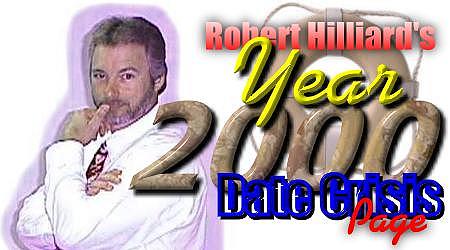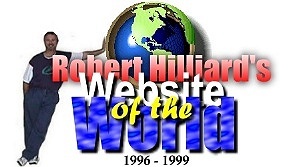If you have a
suggestion or comment,
feel free to send
me e-mail.

Robert Hilliard's Website of the World is featured on such websites as:
ZDNet
Microsoft's MSNBC Technology
miningco.com Orlando, FL.
CMPNet NetGuide
America Online
The Miami Herald
The Dallas Morning News
Peter deJager's Year 2000
BugNet
GeoCities
Massachusetts Institute of Technology
Robert Hilliard's Website of the World has been featured in the following publications:
Web Guide Monthly, (Sept. 1998 Issue)
Rochester Engineer, Rochester Engineering Society, (Oct. 1998)
IFMA Notes, International Facility Management Association, (Sept. 1998)
This website is best experienced with Microsoft Explorer 4.0 (or higher) or Netscape Communicator 4.04 (or higher) at 800X600 display size. Some pages are formatted in frames.
This site

Notice:
The information and material contained on this page are provided "as-is" without warranty of any kind, expressed or implied, including without limitation, any warranty concerning the accuracy, adequacy, or completeness of such information or material or the results to be obtained from using such information or material. Robert E. Hilliard will not be liable for any claims attributable to any errors, omissions, or other inaccuracies in the information or material contained on this page. And in no event shall Robert E. Hilliard be liable for direct, indirect, special, incidental, or consequential damages arising out of the use of such information or material.

About this Website
suggestion or comment,
feel free to send
me e-mail.

ZDNet
Microsoft's MSNBC Technology
miningco.com Orlando, FL.
CMPNet NetGuide
America Online
The Miami Herald
The Dallas Morning News
Peter deJager's Year 2000
BugNet
GeoCities
Massachusetts Institute of Technology
Robert Hilliard's Website of the World has been featured in the following publications:
Web Guide Monthly, (Sept. 1998 Issue)
Rochester Engineer, Rochester Engineering Society, (Oct. 1998)
IFMA Notes, International Facility Management Association, (Sept. 1998)
This website is best experienced with Microsoft Explorer 4.0 (or higher) or Netscape Communicator 4.04 (or higher) at 800X600 display size. Some pages are formatted in frames.
This site


About this Website















The Year 2000 date crisis began as a shortcoming in the storage of calendar data. Back in the days when computer storage costs were high, dates were kept in a six-digit format. The century was left out to save space and thus save money. For instance, the date, June 20, 1999 would be stored as 06-20-99 or 062099. This practice became so commonplace that it spread not only through the computer world, but through the embedded world also. This includes such items as manufacturing equipment, elevators, etc., any piece of hardware or software that stores and processes a date.
The crisis comes full circle when you add the date January 1, 2000. Any system processing a six-digit date will show January 1, 2000 as 010100. This confuses the system. It doesn't know if the date refers to the year 1900 or 2000. Many PC BIOS chips are not programmed to reach the year 2000, so they refer to the earliest date they can which is 1980 or 1982. Some chips will go back all the way to 1900, others will not boot up at all. This is what makes Y2K so complicated. Each computer, each embedded system must be tested individually. Even though two computers may be of the same make and model, their Y2K testing results can be totally different.
The misinterpretation of the year 2000 is bringing about embarrassing results. Companies are spending millions of dollars trying to rectify the problem. The deeper they dig the bigger the problem seems to get. As one computer user put it, "Y2K is like an onion…the more you peel, the more you cry".
Think about it. This could effect every aspect of our lives. From banking to travel...healthcare to retail sales. Every person or company that uses a computer, can be effected. Remember, this not only effects mainframes and servers, but PC's as well!
This page was created to help make our computing world more aware of the year 2000 date crisis and provide information that might help everyone to solve potential problems.

To view an article written by Robert Hilliard as seen on www.year2000.com and www.developer.com, entitled: "The Year 2000: are you a time traveler?"
To view a paper by David Martineau entitled
"The Year 2000 Computer Problem:
A Personal Perspective"


A hard fast look at the Year 2000 situation is coming to light at every organization in the world. After all, 1999 is not just around the corner...IT'S HERE! Organizations are increasingly becoming aware of the Year 2000 date crisis and what they face in fixing their particular problems. The following is a list of Y2K tips that would be excellent for any organization to look at and try to incorporate in their Year 2000 remediation plans:
 Contingency Plans - There is a national push in the Y2K community for completing contingency plans. These are plans outlining what will be done if failures occur on January 1, 2000. If a company cannot use their computers, what manual procedures will have to be implemented to complete everyday tasks and stay in business? Contingency plans must be thought out and documented thoroughly. Decide what time period the contingency plan will cover. Will it be from January 1, 2000 until January 14th? Maybe it will cover December 1999 through January 2000. Who will the plan cover? Employees? Vendors? What procedure will your company follow if a manual process were inacted? Will you need additional employees? Will you need additional desks, typewriters, etc.? What about utilities? Will you need a backup generator for power or an additional water source? What will you do if your business relationship partners (vendors) can't deliver the products you need to operate? A detailed plan must be created outlining every procedure your company will perform in the event of a business disruption.
Contingency Plans - There is a national push in the Y2K community for completing contingency plans. These are plans outlining what will be done if failures occur on January 1, 2000. If a company cannot use their computers, what manual procedures will have to be implemented to complete everyday tasks and stay in business? Contingency plans must be thought out and documented thoroughly. Decide what time period the contingency plan will cover. Will it be from January 1, 2000 until January 14th? Maybe it will cover December 1999 through January 2000. Who will the plan cover? Employees? Vendors? What procedure will your company follow if a manual process were inacted? Will you need additional employees? Will you need additional desks, typewriters, etc.? What about utilities? Will you need a backup generator for power or an additional water source? What will you do if your business relationship partners (vendors) can't deliver the products you need to operate? A detailed plan must be created outlining every procedure your company will perform in the event of a business disruption.
 Create a safety net for incoming products - It's great that you have put in motion plans to check what you already have, but what about items that are puchased and delivered that are Y2K sensitive? Are you putting up a "safety net" so to speak, to check anything that may be purchased and delivered to your door? There is talk that there are companies that are discounting products to buyers because they know they are Y2K sensitive and are not Y2K compatible. There are even companies that feel that to make their products Y2K compatible, it would cost far more than it's worth. Rumors have it that these companies plan to go out of business, then re-emerge after the year 2000 under another name. Anyone within an organization that is responsible for purchasing or receiving purchased goods must be aware of this potential problem.
Create a safety net for incoming products - It's great that you have put in motion plans to check what you already have, but what about items that are puchased and delivered that are Y2K sensitive? Are you putting up a "safety net" so to speak, to check anything that may be purchased and delivered to your door? There is talk that there are companies that are discounting products to buyers because they know they are Y2K sensitive and are not Y2K compatible. There are even companies that feel that to make their products Y2K compatible, it would cost far more than it's worth. Rumors have it that these companies plan to go out of business, then re-emerge after the year 2000 under another name. Anyone within an organization that is responsible for purchasing or receiving purchased goods must be aware of this potential problem.
 Check out and replace critical equipment - The next step is to identify and check out/test any or all organization critical equipment. Run tests on any type of equipment that stores a date. Check out all of your hardware and software. Check your mainframe, your PC's, and check all miscellaneous equipment that you may not suspect could even be involved. Rule of thumb: check out equipment that is vital to the operation and cash flow of your business!
Check out and replace critical equipment - The next step is to identify and check out/test any or all organization critical equipment. Run tests on any type of equipment that stores a date. Check out all of your hardware and software. Check your mainframe, your PC's, and check all miscellaneous equipment that you may not suspect could even be involved. Rule of thumb: check out equipment that is vital to the operation and cash flow of your business!
 Create and distribute an organization-wide newsletter - Let's face it, the more people in your organization you get involved, the quicker you'll get things done. Let everyone be your eyes and ears. Write and distribute a company Y2K newsletter that explains what the Y2K effort is. You can list vital Y2K information including people to report Y2K concerns to. You can also list internet addresses (URL's) that a person might look up on the internet to help them better understand the Year 2000 effort.
Create and distribute an organization-wide newsletter - Let's face it, the more people in your organization you get involved, the quicker you'll get things done. Let everyone be your eyes and ears. Write and distribute a company Y2K newsletter that explains what the Y2K effort is. You can list vital Y2K information including people to report Y2K concerns to. You can also list internet addresses (URL's) that a person might look up on the internet to help them better understand the Year 2000 effort.
Y2K "Trigger Dates"
Date
Countdown
Significance
Jan. 1, 1999
Financial planning software often has a "forecasting horizon"
of one or more years. This date marks a one year
horizon; non-compliant computers will report the year
of dates one year from "99" as "00", which, in turn, will
be interpreted as "1900".
Apr. 9, 1999
This date marks the 99th day of 1999. When jammed
together, the year and day number form "9999", a
date used by some programmers to signal an
"invalid date" condition, or to mean "computer
failure."
Aug. 21, 1999
This date marks the "rollover" of GPS satellite
week counters from 1023 to 0. This may cause problems
similar to the y2k "year rollover" for earthbound
GPS receiver systems.
Sep. 9, 1999
This is the 9th day of the 9th month of the 99th
year. Taken together (9999), they form another
"trigger date", similar to Apr 9th, 1999, with
similar meaning and possible consequences.
Jan. 1, 2000
The "Mother of all dates".
Feb. 29, 2000
The year 2000 is a leap year; but since non-Y2K compliant
computers think 1/1/2000 = 1/1/1900, and since 1900 is NOT
a leap year, 2/29/2000 will mess up day counters of
some software packages.
Thanks to Jack Voltz of Pirate Pete's Page for the Trigger Date Counter
Other Dates To Consider...
 January 1, 2001 - The beginning of the third millennium in the Christian calendar.
January 1, 2001 - The beginning of the third millennium in the Christian calendar.
 February 6, 2040 - Early Macintosh date-and-time utility fails.
February 6, 2040 - Early Macintosh date-and-time utility fails.
 January 18, 2034 - UNIX time calendar fails.
January 18, 2034 - UNIX time calendar fails.
 January 1, 2046 - The system clocks on Amiga computers overflow.
January 1, 2046 - The system clocks on Amiga computers overflow.
 January 1, 2108 - 128 years from 1980. MS-DOS calendar fails.
January 1, 2108 - 128 years from 1980. MS-DOS calendar fails.
 January 1, 10000 - Y10K problem, 4-digit year counters overflow.
January 1, 10000 - Y10K problem, 4-digit year counters overflow.
 January 1, 29602 - Windows NT file system fails due to date representation problems.
January 1, 29602 - Windows NT file system fails due to date representation problems.
 January 1, 29940 - Present-day Macintoshes cannot recognize date after this point.
January 1, 29940 - Present-day Macintoshes cannot recognize date after this point.
 January 1, 292271023 - Java clocks fail.
January 1, 292271023 - Java clocks fail.

To view an article written by Robert Hilliard as seen on www.year2000.com and www.developer.com, entitled: "The Year 2000: are you a time traveler?"
To view a paper by David Martineau entitled
"The Year 2000 Computer Problem:
A Personal Perspective"


Y2K "Trigger Dates"
| Date | Countdown | Significance |
|---|---|---|
| Jan. 1, 1999 | Financial planning software often has a "forecasting horizon" of one or more years. This date marks a one year horizon; non-compliant computers will report the year of dates one year from "99" as "00", which, in turn, will be interpreted as "1900". | |
| Apr. 9, 1999 | This date marks the 99th day of 1999. When jammed together, the year and day number form "9999", a date used by some programmers to signal an "invalid date" condition, or to mean "computer failure." | |
| Aug. 21, 1999 | This date marks the "rollover" of GPS satellite week counters from 1023 to 0. This may cause problems similar to the y2k "year rollover" for earthbound GPS receiver systems. | |
| Sep. 9, 1999 | This is the 9th day of the 9th month of the 99th year. Taken together (9999), they form another "trigger date", similar to Apr 9th, 1999, with similar meaning and possible consequences. | |
| Jan. 1, 2000 | The "Mother of all dates". | |
| Feb. 29, 2000 | The year 2000 is a leap year; but since non-Y2K compliant computers think 1/1/2000 = 1/1/1900, and since 1900 is NOT a leap year, 2/29/2000 will mess up day counters of some software packages. |
Thanks to Jack Voltz of Pirate Pete's Page for the Trigger Date Counter
Other Dates To Consider...

